12 financial indicators to monitor your project

Are you a project or a resource planning manager? Are you part of the PMO or in another project portfolio management role? If you are in charge of a team, you must surely realize that monitoring the performance, progress, workload and execution of projects in real time is far from simple.
There are many KPI in project management. However, to reliably monitor the financial health of a project, it is important to question the relevance of the performance indicators selected.
In this article, we introduce you to 12 indicators to monitor for reactive project financial monitoring.
Project Performance Indicators
Whether the project is internal or invoiced to a client, its management has a cost for the company.
To monitor the performance of a project, there are several metrics that provide visibility on the aspects of progress and good financial execution.
The Completion Rate
Often used in fixed-price projects, it is the ratio between the theoretical valuation of the time to be spent on the entire project, compared to the valuation of the time actually spent on the project.

For example, if a project included a 10-day charge at €800 per day of ADR, but in reality the project took 12 days to complete, the completion rate is equal to 8000 / 9600 = 83.3%.
- Completion Rate Goal
This indicator allows you to situate the real performance of the project in relation to the budget. It is very interesting when it is a project sold at a fixed price and the sale price is directly related to the estimated load on the project.
Thus, when the selling price is decided, it is common to do so by calculating the time to spend making it and multiplying this time by the Average Daily Rate or ADR (if the unit is daylight).
In this case, the sale price can be determined with the following formula: (Time to spend on a project) * (Average Daily Rate (unit = day)).
- Challenge for project managers
The objective is then to keep this number of days planned, or even to improve the organization in order to carry it out with the same quality in less time than planned and/or with more profitable employees for the project. This adjustment is possible by reducing the senior profiles initially staffed on this project in favor of junior employees if the availability of resources allows it.
Under these conditions, the challenge is to continue to ensure customer satisfaction at least as high as with the originally planned plan.
- How to track the completion rate?
It is interesting to look at the completion rate at the end of the project by comparing it to what was initially planned. But it is also and above all during the project that it must be monitored, because it is an excellent indicator of the projected performance of projects.
To do this, it is necessary to have established the budget, but above all to monitor what remains to be done in this project. It is therefore necessary to take into account the time already completed on the project, as well as the time that remains to be produced to complete the work.
When resource planning employees are tracked, the data is already present to calculate this completion rate. Ideally, changes to resource planning will display an immediate reassessment of the completion rate, so that you can check the project's forecast performance and take corrective action before it's too late.

Stafiz is a project management tool that offers you more visibility on the workload of your employees, the progress of your projects and their profitability thanks to a complete real-time forecast reporting.
Budget monitoring of projects, in anticipation
See Stafiz in action in 2 minutes
Margin at Termination
The margin at completion is the projected margin of the project at its completion. The margin at completion therefore takes into account not only the costs already spent on the project, whatever their nature (subcontracting, staff, costs, etc.), but also those to come in order to deduct them from the total projected turnover of the project.
- Margin to Completion's Goal
Margin monitoring at completion is essential for several reasons.
First, to ensure that the projected margin of a project is not negative. Beyond the aspect of good management which encourages ensuring that projects end with a positive margin, this verification is mandatory for accounting in order to be able to pass from provisions for losses to completion if necessary.
In addition, the monitoring of margins at completion makes it possible to better manage costs. There are many levers to improve the margin of a project: re-organizing the resource planning, reduce anticipated travel costs, pick up an additional order, and more.
- How to monitor this indicator?
To reliably monitor the margins at completion, it is necessary to re-estimate your projected turnover, but above all to be able to establish a forecast of future costs.
It is generally the role of the project manager to calculate the initial budget and then to re-estimate, during the course of the projects, all these costs of staff, subcontracting, fees, purchases and any other additional costs.
It is strongly recommended to carry out regular reviews of all projects to identify those that deviate from the budgeted margin in order to carry out corrective actions as quickly as possible.
Production carried out without invoicing
More useful in a time based projects (invoiced by time spent), this metric makes it possible to calculate, as its name suggests, the production carried out (either in value or in time) that has not yet been invoiced to the client.
To calculate this uninvoiced realized production in value, the number of units of time already spent on the project is multiplied by the billing rate applicable to that unit, an Average Daily Rate for example, and this value is then compared with the amounts invoiced to date.
Its formula is as follows: (Number of units of time spent on a project) * (Billing rate applicable to this unit)
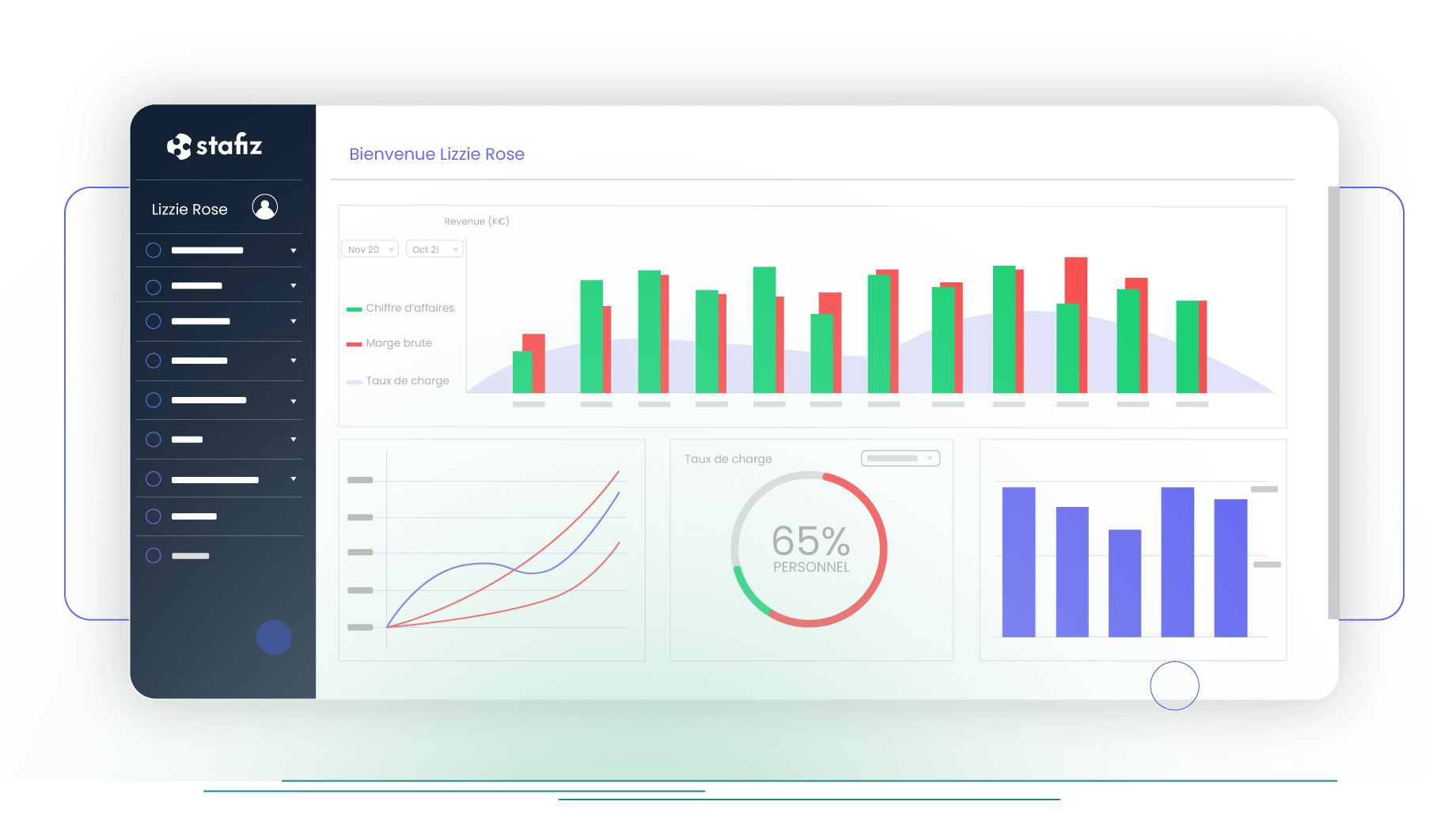
Tracking of uninvoiced production and percentage of completion
- Purpose of tracking uninvoiced production
Knowing the value of the production carried out without invoicing is above all useful for managing cash flow. Regardless of the payment terms, this represents cash that can be recovered in the short term. Of course, it is not always possible to invoice this production immediately according to the deadlines agreed with the customer. However, it is an excellent indicator of future cash flow, especially when it is looked at in a consolidated manner.
- How to monitor this indicator?
It is easier to monitor this indicator through an integrated solution that has the monitoring of the time spent on a project, the Average Daily Rates (or Average Hourly Rates) assigned to each of the resources, and which also manages invoicing, because these elements are compared to each other.
A review of the uninvoiced realizations by division or overall makes it possible to analyze good practices in terms of invoicing.

Progress Percentage
This indicator allows you to check the status of a project's progress. Progress can be analyzed with the unit of time or if the project is associated with a turnover with the unit of value.
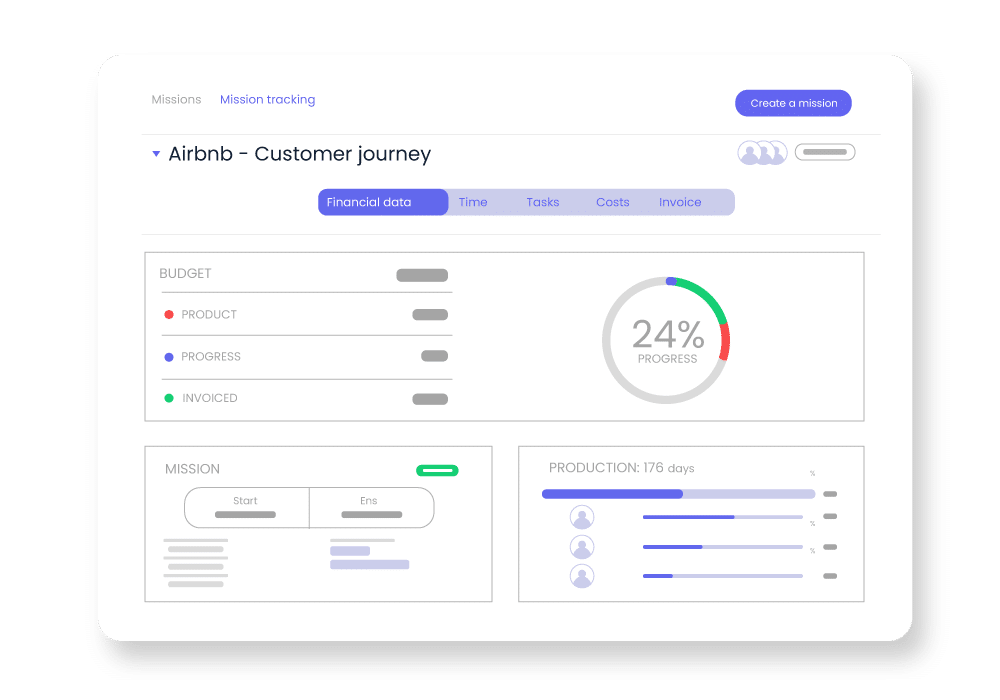
Tracking of uninvoiced completed production and percentage of completion in Stafiz
This percentage of progress can also be analysed in relation to the initial budget or in relation to the last estimate. When your management tool calculates a turnover at the time of progress, it is also possible to know the progress as a percentage of the turnover.

- Progress Percentage Goals
It is important to track the percentage of completion to ensure that objectives are met. Completing deliverables on time is a major objective of project management.
This target is also often analyzed in conjunction with another metric, On-Time-Delivery, which calculates the number of projects completed on time as a proportion of total projects. The project manager must therefore always keep a close eye on this important project management metric.

- How to track progress percentage?
You have to compare the budget in terms of time and value to the actual budget, which is based on the employees' activity reports. When the project management tool you use also allows you to re-estimate the costs of projects, the progress can then be measured against the last forecast, so it is more accurate.
Indicators related to team management
The utilization rate (or billable utilization rate)
- Purpose of the utilization rate
The activity rate, excluding holidays, ensures that the teams produce work that will bring profitability at the expected level. When projects are invoiced to clients such as in service companies – such as consulting firms, IT Services or agencies, the turnover, depends directly on the Project invoicing.
It is therefore essential that the company's main resources, namely its employees, use their time to work on billable, i.e. revenue-generating projects, rather than on internal projects, although the latter can have a favourable impact on profitability (deployment of an ERP solution to generate productivity gains, simplification of processes, commercial activity, etc.).
It is not uncommon to set different workload rate targets for different employee populations. For example, in a consulting firm, junior employees are often expected to have a utilization rate very high, often above 80%. On the other hand, managers spend more time developing the business and therefore have objectives of utilization rate lower.

- Utilization rate: how to track it?
Monitoring employees' activity must make it possible to allocate time not only to projects that can be loaded, but also to all the projects and activities on which they are required to spend time: training, internal projects, work on commercial proposals, etc.
Activity tracking software (Compte Rendu d'Activité) must enable time to be allocated to all these categories, and provide consolidated reporting, to give visibility on past and future utilization rate (the latter depending on resource planning), by employee, team or type of employee population. With this visibility, it's much easier to identify the issues that stand in the way of improving profitability.
occupation rate
- occupation rate's goals
Unlike the utilization rate, the occupancy rate will make it possible to monitor the overall workload of employees, whether on projects sold to customers or on any other type of activity. Some employees, even if they have utilization rate weaker ones do not necessarily have less intense activity.
A finance manager, for example, will work more on internal projects than other employees, often with a heavy workload. They will then have a high occupation rate.
The occupation rate is calculated by the following formula: 
- How to monitor this indicator?
It is particularly interesting to have a predictive view of this metric. Seeing the workload of employees in the coming periods, not only on projects but also possibly on other categories of activity, makes it possible to identify the problems of overcapacity or undercapacity that are materializing. It will thus be able to react and correct the course by hiring, for example, in the case of undercapacity. To optimize resource management, it is important to have project governance in place to stay aligned with business objectives.
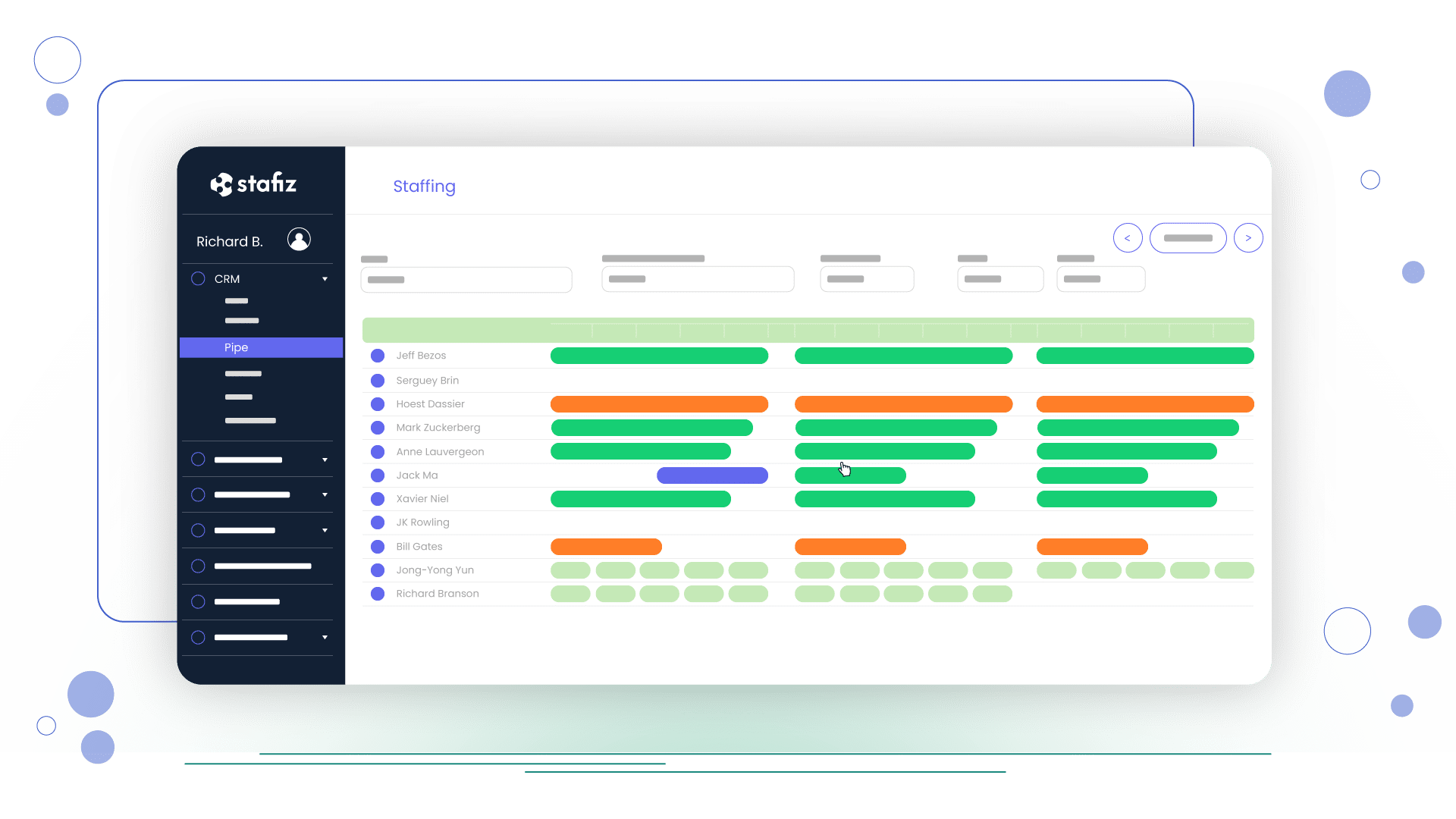
occupation rate tracking in Stafiz
Production
Production, when defined as part of a project, can be tracked in value or time (usually in days or hours).
When we look at the production carried out in days , for example, it is the total time spent on a project to date.
For the production achieved in value, it is the total number of days spent on the project multiplied by the value of one day (often referred to as the Average Daily Rate). Its formula is as follows: (Number of days spent on a project) * (Value of one day).
- Production monitoring purposes
It is often interesting to track production and production capabilities at the level of a team or company. Depending on the number of employees and their availability, it is possible to read the production capacities in days or value. A well-organized and optimized company will always seek to align its production capabilities with its revenue objectives and growth. So, being able to track this metric helps ensure that business goals are aligned with available resources.
- Example
JAVA has 100 developer employees, including the ADR is set at €800 as standard, and 50 consulting employees who have a ADR of €750. On average, all employees work 217 days. The total production capacity is therefore :
[100 x 800 + 50 x 750] x 217 = €25,497,500.
Theoretically, if the teams stay at the same level, you have to go for at least a contract amount of €25.5 million.
- How to monitor this indicator?
In an activity management solution, you often have the possibility to track the production carried out, but also sometimes the planned production. When forecasts are also available, it makes it possible to know what capacity remains in the next periods, i.e. the commercial effort to be made to cover at least the company's resources.
Indicators related to the overall project financial monitoring
If you are in charge of several projects or you are a manager, you also need to track metrics that give you a more holistic view of the performance of the activity. It is therefore interesting to follow these three indicators.
Commercial pipe
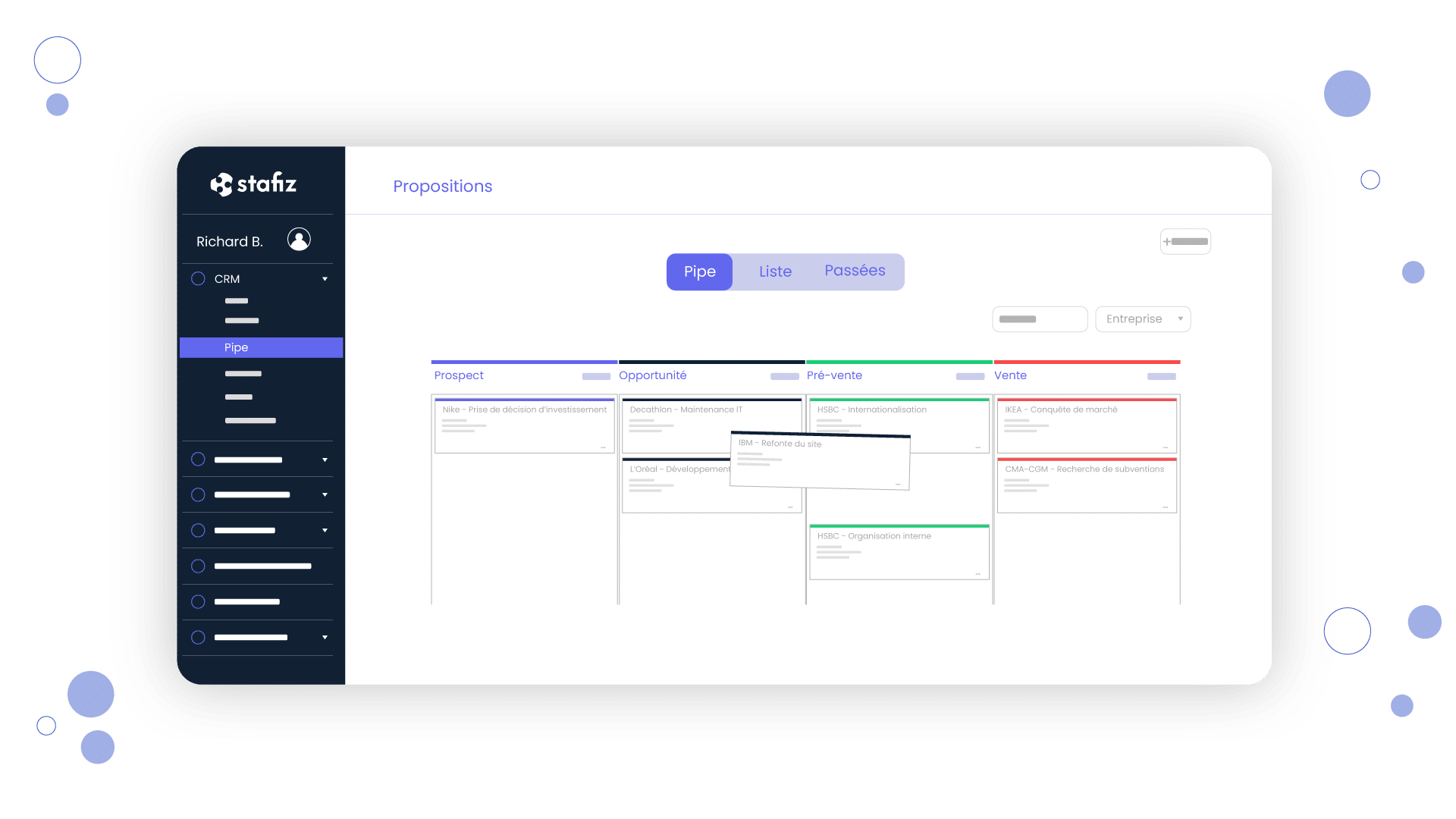
Commercial pipe tracking
pipe corresponds to opportunities identified but not yet won. Monitoring the pipe sales pipeline enables us to anticipate future sales linked to these opportunities.
- Pipe monitoring purposes
Keeping track of pipe sales is crucial for any company, not just those working in project mode and selling services. As well as anticipating sales performance and being able to forecast future sales, this monitoring enables us to anticipate resource requirements in order to respond correctly to future projects.
It is in this context that it is crucial for team leaders and managers to have a good visibility on the maturity of opportunities and the associated resource needs.
- How to track the commercial pipe?
It is imperative to have a project management tool to centralize all the opportunities, and if possible segment them by maturity or chance of success.
Ideally, it is possible to identify the stage of progress of the opportunity (prospecting, offer sent, negotiation in progress, etc.) and to apply a percentage of chances of success that allows you to weight the associated amount and provide a more realistic vision of future turnover.
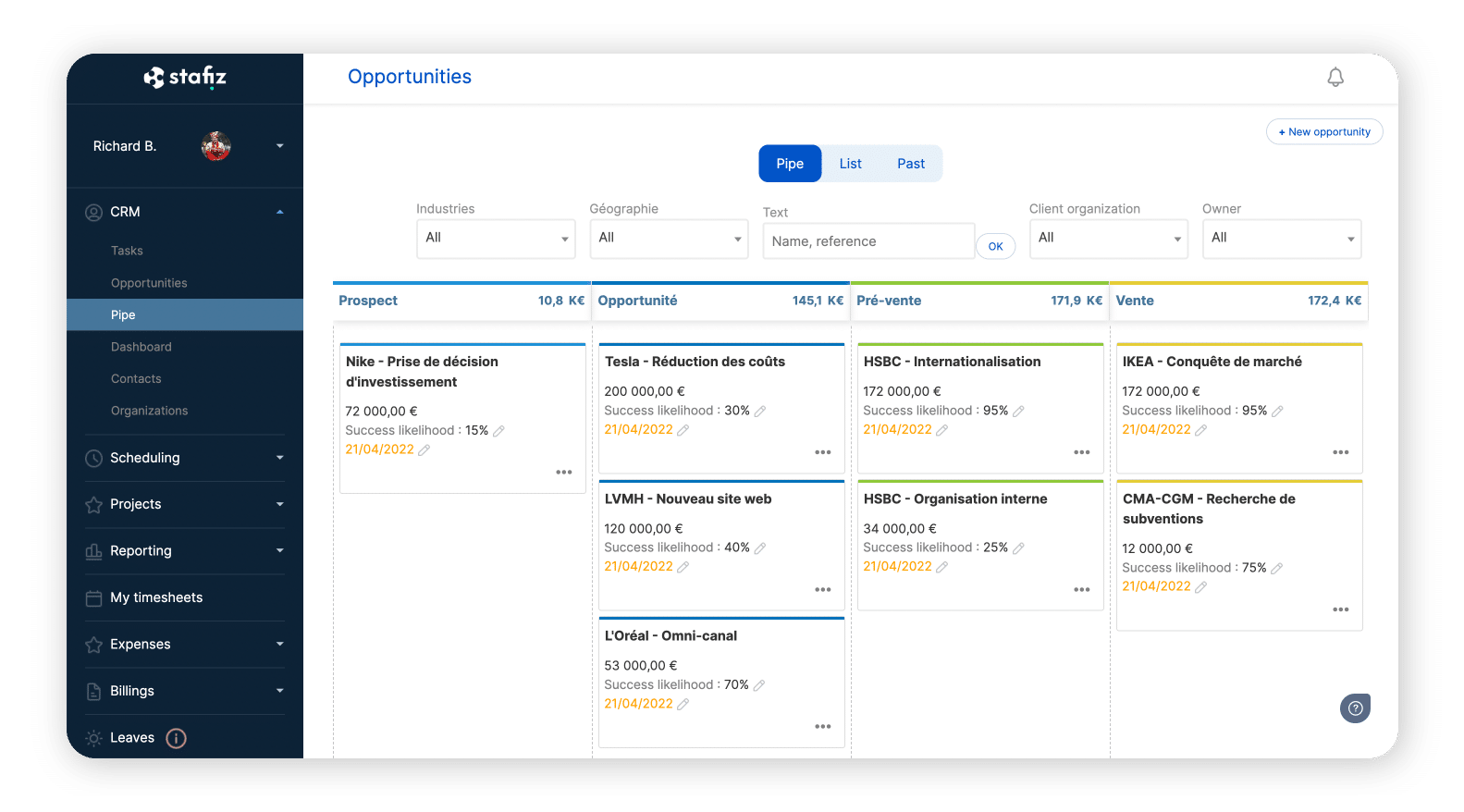
Business Opportunity Management
Pre-staff your teams and anticipate your resource needs as soon as the opportunity arises with Stafiz. Once the opportunity is won, the project creation is automatic, keeping the data from resource planning and budget information previously provided to save you time and better optimize the load.
When CRM is adapted to resource management, it can also be used to edit an associated workload plan: what types of roles will work on this project if it is won, for how long, at what Average Daily Rates, and what skills will be needed?
Depending on the maturity of the offer, it is possible to "push" the needs to the planning managers or team managers so that they can identify the employees who will be able to meet the need, or, on the contrary, can alert to identify external candidates or subcontractors.
Link the pipe to make sure that the right casting is done to meet the needs of the project.
The Cost of Customer Acquisition
It is the set of commercial costs that are necessary to sell the projects. This is the time spent by the teams writing proposals, the time spent on the sales activity or on the road to discuss with prospects. It is also travel expenses in the pre-sales phase or all other expenses incurred as part of a call for tenders, for example.
- Acquisition Cost Tracking purposes
Monitoring customer acquisition costs is another crucial indicator for ensuring the profitability of sales activity. In a way, it's the investment needed to land projects.
It is necessary to ensure that the value generated by the contracts associated with the activity is much greater than this commercial investment. The ratio of 3 times the value to the acquisition cost often stands out as the minimum to be reached to maintain good profitability.
Well monitored, this indicator also makes it possible to compare the performance of salespeople with each other. This is an excellent indicator that goes beyond the amount of turnover earned by the salesperson.
- How to track the acquisition cost?
To be able to track business activity and costs, it is necessary to have a solution that allows you to track the time spent, expenses and expenses and to allocate them to each of the opportunities, or to more general activities, such as prospecting by email or participation in a trade show for example. Having knowledge of the cost of each salesperson, it is then possible to calculate the total sales cost spent on each opportunity and on other sales activities, per employee.
Depending on the project management tool you use, you will be able to track and generate reports that give more precisely the overall acquisition costs, by team or by salesperson, and the profitability of this cost in relation to the amounts of revenue earned.
Actual and Projected Revenue
Calculating turnover for projects can be quite complex because several methods are used, such as the progress method or the completion method for example.
The progress method will make it possible to recognize the turnover in the income statement according to the percentage of completion. This percentage of completion is generally calculated as a percentage of the costs charged to the project compared to the total costs planned on the project. It is calculated as follows:

Via the completion method, the turnover is only recognised at the end of the project.
- Purpose of Revenue Monitoring
There is no doubt that tracking project revenue is a key KPI. Whether projects are invoiced internally or to clients, applying revenue helps to value the time spent by resources on the project.
Even if you are working on internal projects that are not invoiced, it is interesting to apply an Average Daily Rate to your resources, to identify the equivalent in turnover that could have been generated by the resources if the project had been sold.
- How to track turnover?
Sales tracking can be quite complicated, depending on the size and duration of projects. The financial teams in charge of this often use Excel models, but the use of an ERP solution that can automate and secure the calculation is an asset, not only for the time savings it brings to support teams, but also because this metric is so important that it needs to be tracked in real time not only by financial teams, but also by project managers and other managers.
Profitability Monitoring
Tracking the profitability of an entity that carries out projects involves being able to track the profitability of different projects and being able to analyze the different types of costs: team costs, subcontracting costs, fees and other types of expenses, etc.
- Profitability Monitoring Goals
This monitoring ensures that the activity generates profits at the expected level. Not all project activities are intended to generate profit, but when they do, it is important to have a global view of the profitability of the activity by tracking the past and future profitability of the projects and comparing it to the budget.
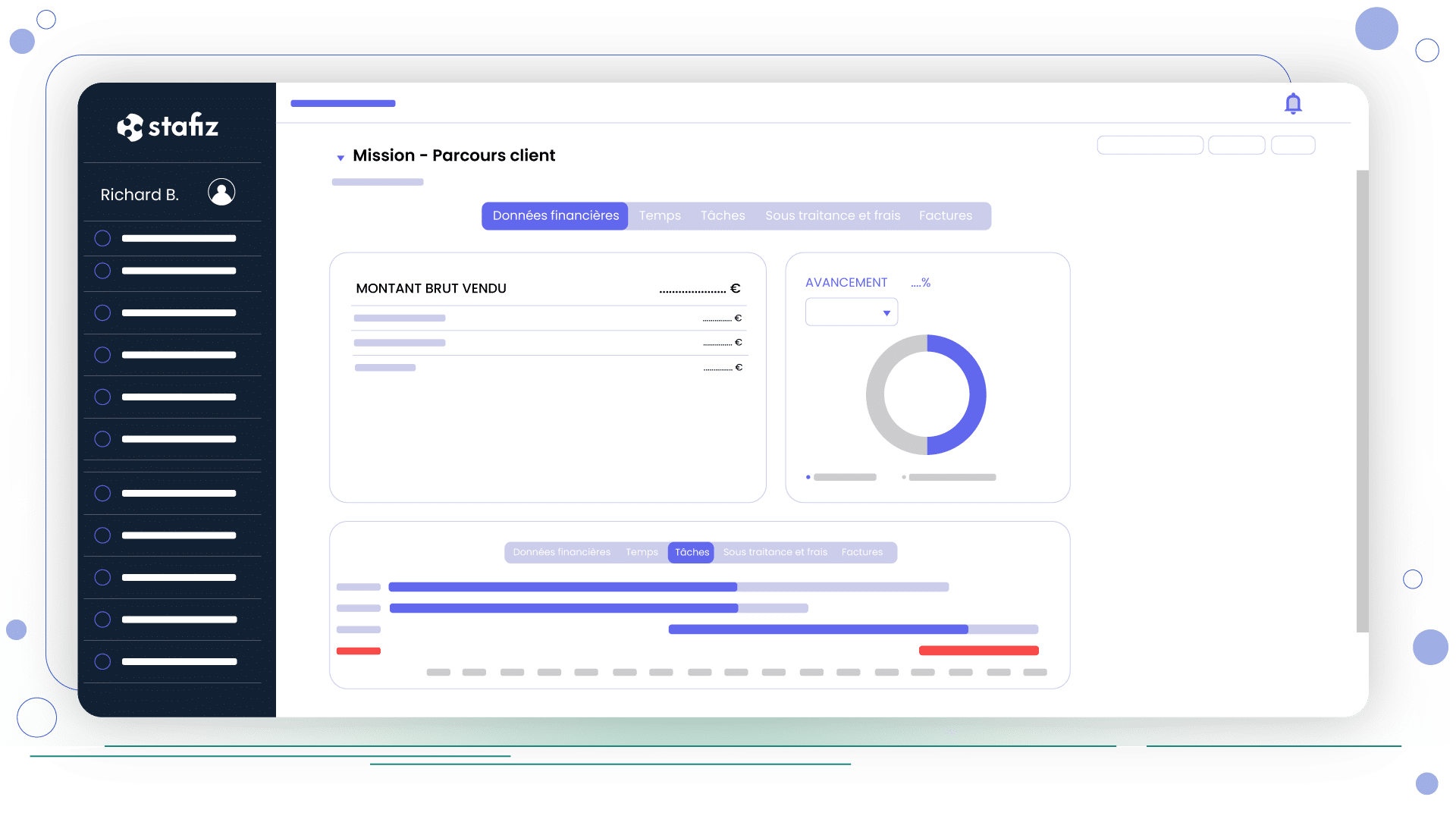
Monitoring the profitability of the activity in Stafiz
- How to monitor the activity's profitability?
Here, too, Excel-based tracking can do the trick when there aren't many projects, but using a dedicated solution brings a host of advantages, from automated tracking to secure calculations, not to mention tracking dashboards that enable you to immediately identify budget overruns and the reasons for them, and pinpoint any discrepancies.
Project invoicing
The aim here is to monitor the progress and completeness of the invoicing in relation to what was envisaged. This monitoring must go as far as monitoring payments to have a good control of your cash flow.
- Purpose of billing tracking
The performance of the activity does not stop at the realization, it is necessary to ensure that the amount sold is collected and if possible as quickly as possible in order to have the healthiest cash flow possible. It is therefore necessary to ensure that the process is organized.
- Invoicing deadlines, i.e. the deliverables that will trigger invoicing, are tracked and that communication between project managers and invoicing teams is excellent to allow invoicing as soon as possible.
- All billable items have been invoiced and nothing is forgotten: in a project, not only are the deliverables billable, but it is also common to re-invoice fees for example. It is important to follow up on these elements, otherwise re-invoicing is forgotten and money is left on the table.
- The terms of payment are respected by the customers
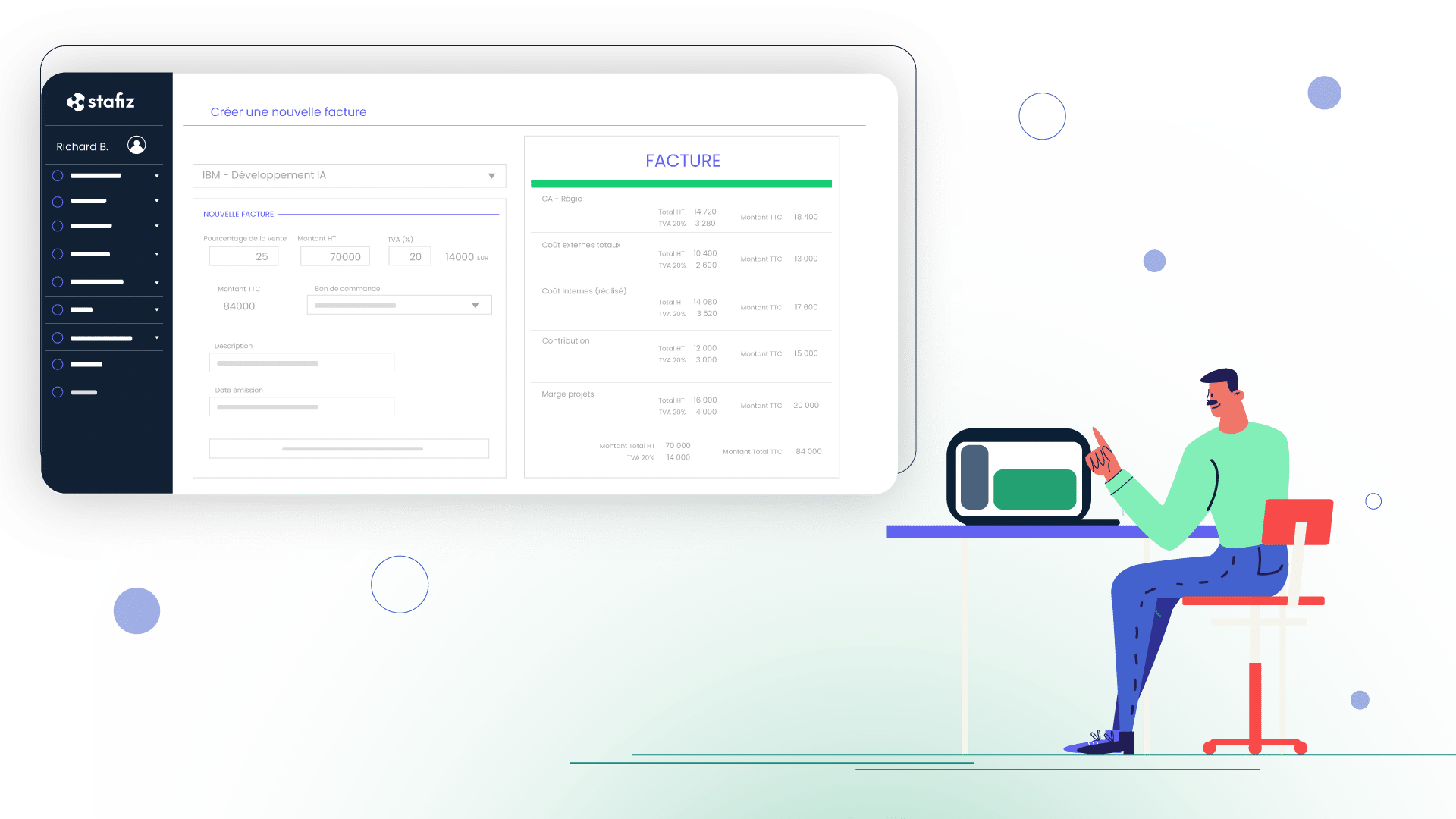
Project invoicing tracking with Stafi
- How to monitor this indicator?
It is necessary to track project by project what has been invoiced, what remains to be invoiced, what has been paid and to be able to easily identify the invoices that have not been paid when they should have been. It's always easier if the invoicing follow-up is linked to the project follow-up.
When the progress tracking and invoicing elements are linked, for example, it is possible to let the project manager confirm the production of a deliverable in order to trigger an invoice. The teams in charge of invoicing then see this deadline appear as an invoice to be issued, and can send it to the customer as quickly as possible. By accelerating the cash flow cycle, the entire cash flow of the business improves.
Stafiz helps service companies gain visibility and better manage the progress of their projects with real-time data. Stafiz is a SaaS for managing the resource planning, project management and Business Intelligence. This way, budgets and margins are always respected and you make better decisions for your business.
Project Portfolio Management in Stafiz
Questions:
For effective financial monitoring, focus on metrics that measure performance against budget and schedule, such as:
- the actual cost,
- the completion rate,
- the projected margin,
- the cost performance index,
- the utilization rate,
- the rate of advancement,
- the margin at termination.


